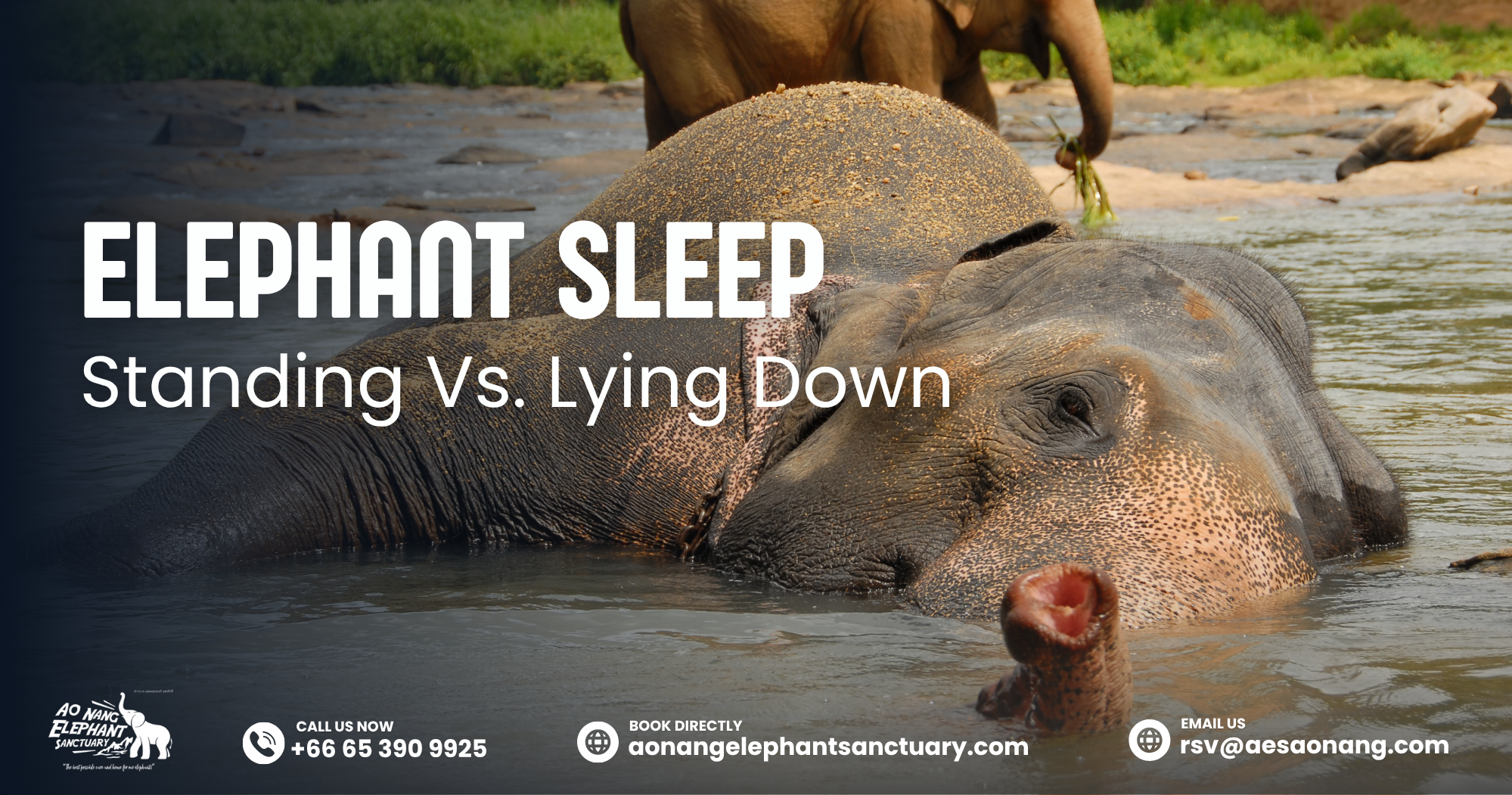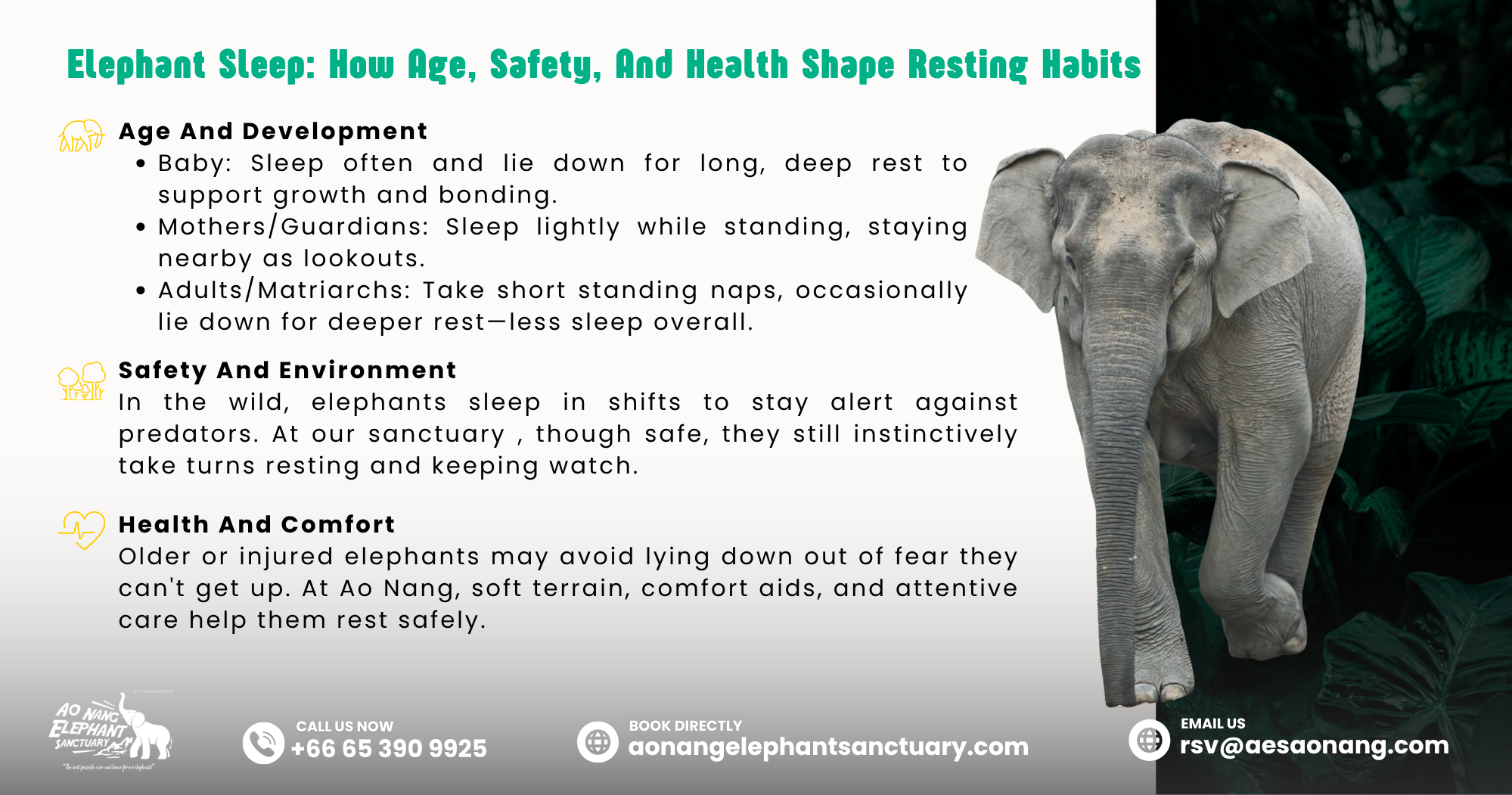The Ao Nang Elephant Sanctuary in Krabi, Thailand, is the place where people often ask how elephants sleep. These Asian elephants, which were saved and now live there, are very happy with the big space and natural habitat where they can sleep whenever they want.
Unlike zoos or work camps, Ao Nang’s elephant herd lives in a semi-wild environment. Here, they are free to do whatever they want, such as roaming, eating, and sleeping without any restrictions or commands.
In their natural environment, elephants are known for their very short sleeps (usually only 2-4 hours during the night), and they do this while standing most of the time. But research shows that they are allowed by their nature to lie down when going to sleep deeply if they are in a place where they feel safe.
At our sanctuary, visitors may easily notice elephants that are asleep or resting in the mud or under the trees. We look at their sleeping patterns below—why and when they are standing or lying, and how the kind, caring team of Ao Nang helps elephants to have their natural sleep.
Elephant Sleep Habits And Sanctuary Care
Elephants are one of the lightest sleepers among all animal species. The average amount of sleep for wilderness elephants is only about two hours during the whole day, mainly at night. They are often found sleeping in short bursts, and they mostly spend the night standing and dozing.
Besides, this very little sleep is enough for them to be watchful throughout the night: the naps taken while standing allow them to react quickly in case of danger. In dangerous places, the groups even distribute the sleeping times so that some are sleeping while others are on the lookout.
At Ao Nang Elephant Sanctuary, the situation is more relaxed. There are no killers, no chains, and the elephants have guaranteed food and water. Hence, our elephants are happier to lie down for deeper sleep than they would be if they were in the wild. This shift in elephant sleep behaviour shows how a safe and nurturing environment can improve their rest quality.
Animals in captivity or sanctuaries normally sleep longer and more times, and go into REM (deep) sleep more often, than their wild counterparts. Accordingly, you can often observe Ao Nang’s elephants lying on the soft earth or rolling in mud during their naps. The sanctuary’s forested paddocks with soil and water are perfect, calming conditions for the elephants to rest naturally.
Does An Elephant Sleep Standing Up Or Lying Down?
Elephants can sleep both while standing and lying down; however, the two positions have different functions. If an elephant is sleeping while standing, it is still in a light, dozing state. This allows the elephant to keep an eye out for any threats and be able to get up quickly if necessary. Standing sleep is usually just a short nap rather than deep sleep.
Elephants reach the deepest rest and the REM (Rapid Eye Movement) stage only when they lie down. The lying position additionally eases their limbs and thus, they can have a very deep and refreshing sleep.
Practically speaking, at Ao Nang Elephant Sanctuary, the two elephant behaviours can be exhibited. Swaying and dozing elephants are commonly seen after they get some food. However, when they make themselves comfortable, especially after a strenuous day, for a long, deep sleep, they usually fall on their sides.
The sanctuary cameras and research support show that captive elephants lie down more times than the wild ones. Our elephants feel that here they can rest fully.
Usually, young and healthy elephants take full-body rests, while older or arthritic elephants might lean on a sandpile and logs if they are not able to lie flat at the time.
Sanctuary Environment And Natural Rest
Elephants at Ao Nang follow an ethical care model that highlights natural living. The elephants are running freely in forested valleys, and they were never chained. They not only have access to soft soil and grass but also to river streams and mud walls, which are parts of nature and promote comfort and healthy elephant sleep habits.
For instance, when elephants are in our mud pools, they frequently roll and lie down to scratch and cool off, which is also a relaxing activity. On the other hand, animals that were kept on concrete or in tight spaces before are the ones who are probably going to refuse to lie down. Hard and dirty floors would make them feel pain while lying down.
Elephant sleeping is further supported by veterinary checks and the comfortable facilities we have to offer. We have happy elephants, and they eat good food, and they are also with a well-balanced herd. Stress is kept to an absolute minimum so their natural sleep rhythm, which was disturbed earlier by the stress, can get back.
In essence, living in Ao Nang Elephant Sanctuary is like being in a semi-wild state for the elephants. Our guides and mahouts confirm the fact that after having food and getting a shower in the evening, the elephants do not hesitate to take a nap. Some of them do it standing, while others do it lying down.
Elephant Sleep: How Age, Safety, And Health Shape Resting Habits
Elephant sleep patterns also vary by age, safety level, and individual health:
Age And Development
Newborns and small elephants are the ones who need a lot of sleep; that is the reason why, for their growth and learning, they are given it. Due to this, they have the habit of lying down and taking a sleep of longer sleep frequently. They thus become able to find the warmth and protection that they seek, despite talking about just one or two of them as if they were a big family.
In a wild elephant herd, as well as a sanctuary one, the mother or an older elephant, in general, is the one who usually performs the role of a lookout while the baby is sleeping, as she often stands nearby to keep watch.
On the contrary, adults and matriarchs are more likely to sleep less. Mature elephants generally take a few short naps while standing and only occasionally lie down for a longer rest. These patterns of elephant sleep shift with age and responsibility.
Safety And Environment
Wild elephants are only partly upright because they are still predators’ targets. Their herd members are there to share the job of vigilance. While some elephants stay alert, others sleep.
At Ao Nang, however, there are no predators, so all elephants can relax. Though the situation here is the same, the herd’s instincts are still there. The observations reveal that elephants swap jobs of sleeping deeply. So, at least one or two of them are standing nearby, like in the wild.
Health And Comfort
Sometimes old elephants or those with injuries refrain from lying flat on the ground. For instance, they have done that to injured elephants at other places by giving them piles of sand or thick bedding so that they can rest. They may be afraid that they will not be able to get up.
At Ao Nang, the natural terrain, such as soft soil and mud, allows older or arthritic elephants to lie down more safely. In addition, our team gives supplemental sand piles or rubber mats besides the sleeping areas.
If there is a case where an elephant shows unwillingness, caretakers do their best to provide comfort since the elephant will be more willing to rest.
Generally, if elephants at Ao Nang are given good health care and are in a stress-free environment, they can achieve the rest they need.
Observe Elephant Sleep In A Safe, Ethical Sanctuary
In case you still remember when you were wondering if elephants are more comfortable when they sleep while standing or lying down, there is no other way to find out but to experience it yourself.
You have to visit Ao Nang Elephant Sanctuary to see the elephants sleeping naturally, just like it is at their home. You will gain a great understanding of the elephants’ behaviour, and be able to tell the story of the moment when you witnessed an elephant calmly sleeping under the Thai sky.
Reserve your spot now to get a chance to meet Asian elephants!
- Phone: +66 65 390 9925
- Email: [email protected]
- Book directly at aonangelephantsanctuary.com




